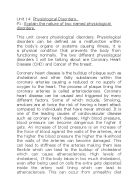Blood tests pick up abnormalities that influence how well the heart is working. For example, they can detect raised levels of cholesterol (which may lead to coronary artery disease), abnormal levels of thyroid hormones (which can affect the heart's strength and rhythm) and the presence of cardiac enzymes (chemicals released when heart muscle cells are damaged in a heart attack).
High resolution images of the heart, brain and blood vessels are given by X-ray computed tomography (CT) or computerised axial tomography (CAT) scans. It's useful to evaluate disease of the aorta - the largest artery in the body and involves little potential risk to patients. In stroke patients, it gives valuable information about the location and extent of brain injury. A magnetic resonance imaging (MRI) scan produces detailed pictures of internal organs, including the heart and brain. Patients lie in a short tunnel-like machine which contains a cylindrical magnet. Short bursts of magnetic fields and radio waves create images of parts of the body as required. MRI can measure the flow of blood through some of the major arteries and can detect abnormal heart function in disorders such as cardiomyopathy (heart muscle disease), coronary heart disease, and congenital heart defects and help define the location and extent of brain injury in stroke patients.
Breast cancer also has many investigations that take place before a diagnosis can be made. These can include the following.
A biopsy is when a sample is taken of the lump or abnormal area. The biopsy sample is then analysed in a laboratory and the cells are examined. This allows the doctors to see exactly what type of cancer it is and whether it’s likely to grow slowly or more quickly.There are different types of biopsies that can be used including; Core needle biopsy; blood tests; Fine needle aspiration; Excision biopsy.
Scans can measure the size of the cancer and whether it has spread to other parts of the body or nearby lymph nodes (glands). This process is called 'staging' the cancer. Once the type and stage of the cancer is known, the doctors can discuss with you how best to treat it.The different types of scans that can be sued include ultrasounds, mammograms and Magnetic Resonance Imaging (MRI)
Ultrasound is an imaging technique that uses sound waves to create a picture of the breast tissue. It is generally used as a complementary test to a mammogram. An ultrasound is the best way to check whether the lump is solid (made up of cells) or filled with fluid (cyst). It can also identify whether a solid lump is benign or malignant.
A mammogram is one of the most important tools to diagnose breast cancer. A mammogram uses low-dose X-ray on the breast tissue to obtain a picture of the insides of your breasts. It’s used mostly for women who are older than 35. In younger women the breast tissue is more dense so it’s more difficult to detect any changes in the breast. The procedure is very safe, and it doesn’t take more than 20 minutes. There is some discomfort and pain in the breasts when the breast is pressed on by an upper and a lower plate.
Magnetic Resonance Imaging, or MRI, is another imaging technology used in the diagnosis of cancer. Unlike a mammogram that uses X-rays to get the images of the breast, MRIs use magnets and radio waves to create 3D images of the breast tissue. Sometimes a dye is injected in your arm. Cancer cells need a large amount of blood supply for their growth, and the MRI shows where and whether the dye is concentrated in certain areas indicating cancer cells, and in the picture it appears as a white patch on the dark background.









